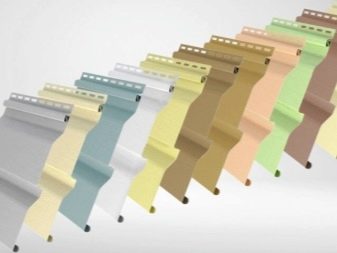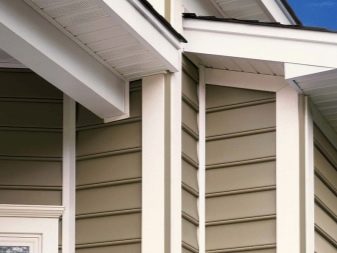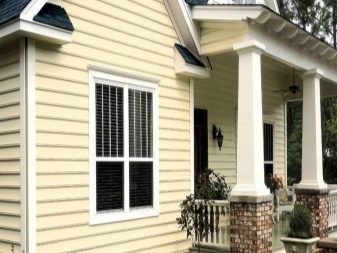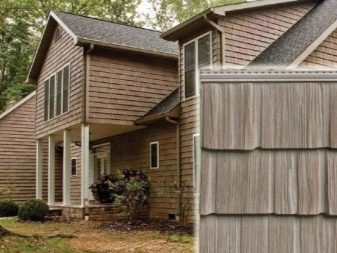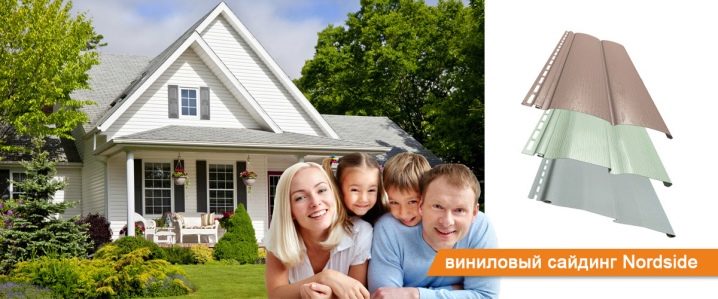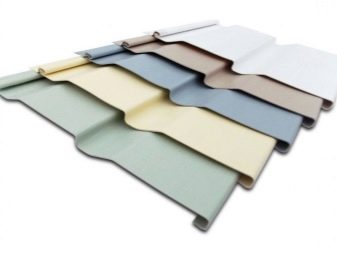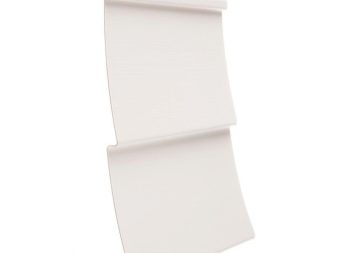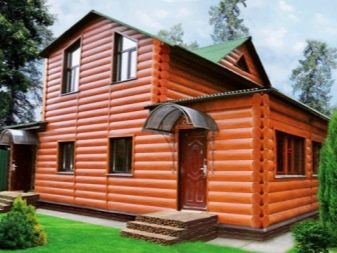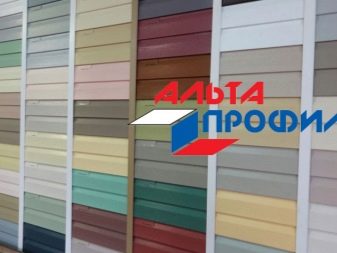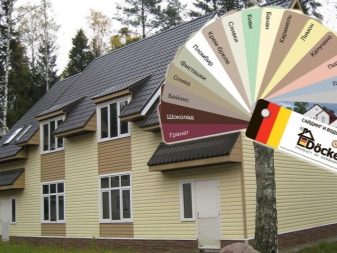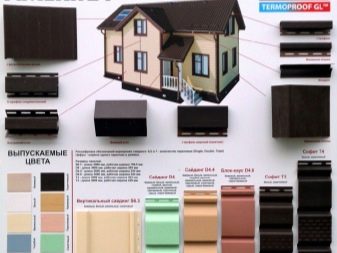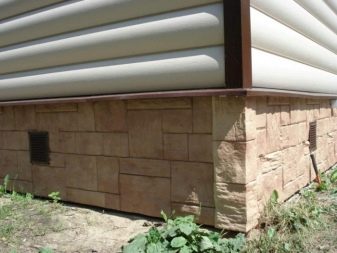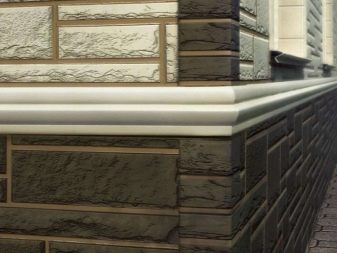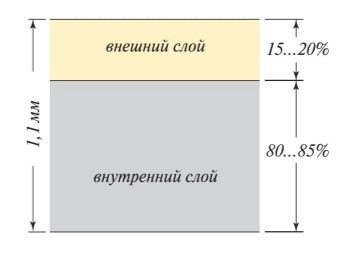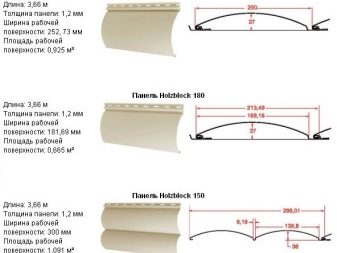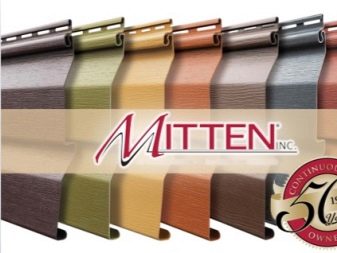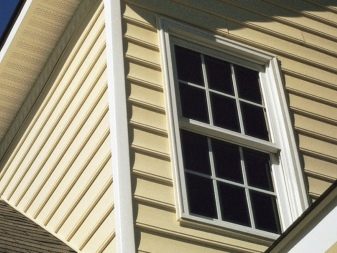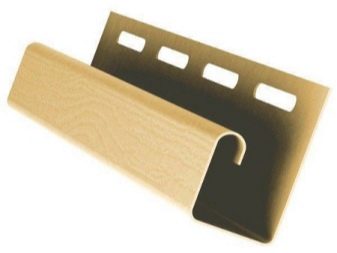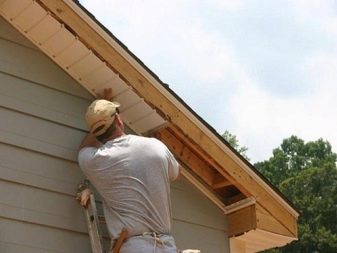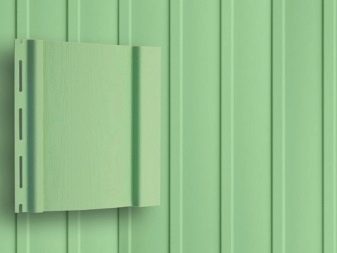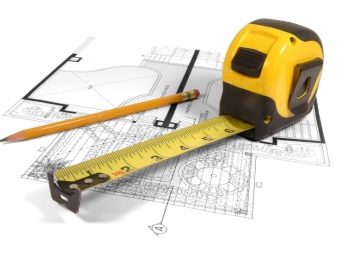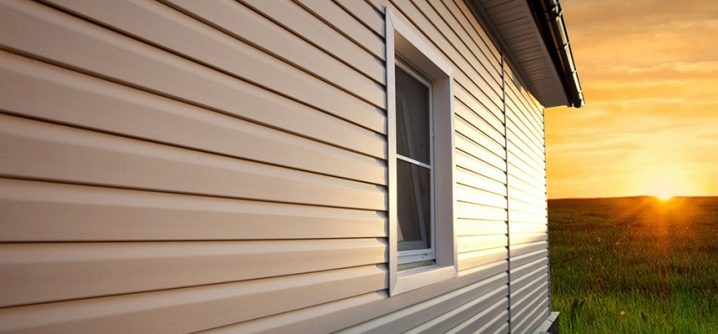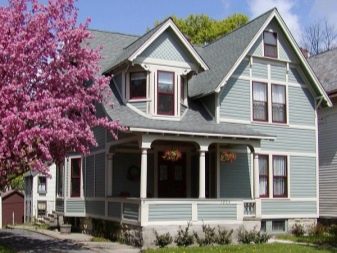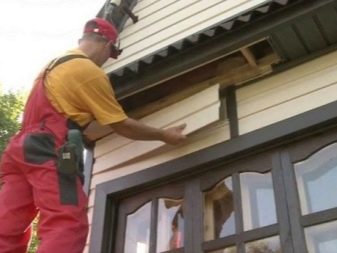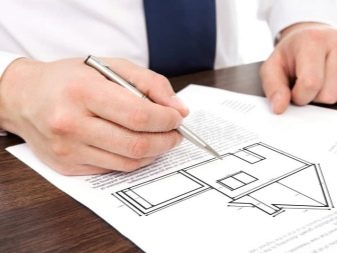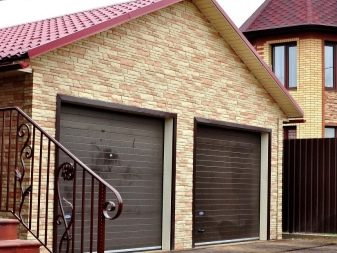Sizes of vinyl siding
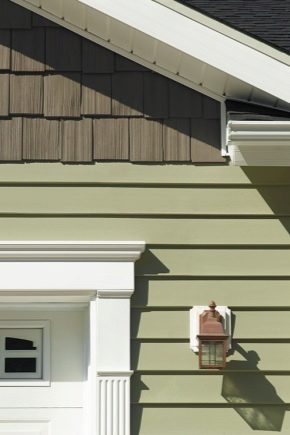
Vinyl siding is a practical and inexpensive finishing material used for exterior cladding of buildings. It is a PVC panel of a certain size, which provides a low weight of cladding (additional strengthening of the foundation is not required), its moisture resistance and resistance to environmental influences, and bioresistance. As for strength, it is quite high (although it is inferior in terms of this indicator to metal siding).
Main settings
With the help of vinyl siding you can achieve original stylistic effects, since the panels are externally very diverse. There are options that imitate stone, wood, brick surfaces.Moreover, the similarity is so close that it is possible to detect imitation only upon closer examination.
Mounting siding panels produced on the crate, use of a heater is possible. If the walls are smooth and do not need thermal insulation, then installation directly on them without crates is possible.
Siding is available in the form of panels, which may have different dimensions. Standards governing the size of profiles do not exist. Each manufacturer produces panels of certain parameters. In addition, the dimensions may depend on the installation of siding (vertically or horizontally), on its purpose (front or basement).
Length and width
Average lengths and widths that vinyl siding can have are:
- length - from 2500 to 3750 mm;
- width (working) - from 220 to 275 mm;
- width (useful) - from 200 to 255 mm.
The length and width of the plastic siding may also depend on the type of surface it mimics.
- Shipboard panels have a length of 3000-3390 mm (shortened version) and 3660-3810 mm (standard version). The shortened panels are distinguished by simpler installation; by joining, the required length can be assembled from them.The width of the panels under the ship's board varies within 172-232 mm. Sometimes it is more rational to use wider “boards” to avoid having to cut panels. Their width is from 240 to 255 mm, however, there are also models with a width of 305 mm.
- Herringbone Width depends on how many waves it has. In accordance with this, single “herringbone” (marked with S), double (denoted as D), triple (denoted by the letter T) are distinguished. On average, the width of a single wave is 114.3 mm; in order to find out the width of a double and triple fir tree, it is enough to multiply this indicator by 2 and 3. When buying a fir tree from the USA or Canada, you can find that the length of one wave is indicated in inches. The standard is 4.5 inches wide, which is 114.3 mm.
- Block house (imitation of the log surface) usually has a width of 240 mm with a length of 3660-3810 mm. The widest width is characterized by a perforated spotlight, used to design the bottom of the gable and eaves roofing overhangs. Its width is 305 mm with an average length of 3050 mm. Material parameters are variable, depending on the brand issuing them. Thus, the company "Alta-profile" produced siding "shipboard" the size of 3100x230 and 3660x230 mm.
2 cm wider profiles of the German brand Docke ("Duke").One of the most dimensional panels are produced by the Grande Line company (“Grand Line”). Their length and width are 3000x238 mm. The smallest width has the products of the company Mitten. In the manufacturer's lineup there is a profile 178 mm wide, whose length is 3040 mm.
Depending on the purpose of siding, it can be front and ground. The dimensions of the first were discussed above. For a more simple design of the base, small rectangular panels are used. In most cases, their dimensions are enough to fix the material on the basement of the building in one width.
Among the most popular basement panels, you can select profiles with the size of 1140x480 mm and 1135x474 mm. In such sizes, tiles are produced from one of the leading manufacturers - Alta-Profil. Minor resizing is associated with the surface features of the material. So, the “Stone” collection is presented in sizes of 1135x474 mm, and the collection imitating stonework contains panels of smaller sizes - 1130x468 mm.
It is important to distinguish between working and useful siding area. When calculating the required amount of material should be considered only the latter.When considering a siding panel, you can find that part of it has perforations. It is necessary for fixing subsequent panels and after installation is hidden from view, and, therefore, should not be taken into account in the calculations.
Thickness
Its strength characteristics largely depend on siding thickness. For facade panels, the standard thickness is 0.6-2.0 mm. However, today the market can meet the panel thickness of 0.4-0.6 mm. They are of domestic or Chinese origin. Profiles from European manufacturers cannot be thinner than 0.6 mm, since this parameter is regulated by a strict standard.
It is recommended to purchase siding, the thickness of which is not less than 0.6 mm. Thinner materials cannot guarantee reliability.
Different manufacturers can change the thickness of the panels. For example, siding from the Canadian company Mitten has a thickness of 1.02 to 1.2 mm, depending on the product line. Southern Beaded siding is 1.14 mm thick.
Finally, siding thickness is determined by its purpose. More dense panels are called basements and are designed to trim the bottom of the facade. The thickness of such profiles is more than 2 mm, and sometimes it can reach 4 mm.This is due to the fact that the basement part is more susceptible to moisture, frost, mechanical damage.
Sizes of accessories
Given the dimensions of the panels and calculating their number, it is important to clarify the dimensions of the components. As a rule, they are similar to panels, but this is not always the case. J-trim strips have the same length with most siding panels, but they are not suitable for installation in conjunction with Docke panels, since they have a shorter length.
The outer and inner corners have a length of 3050 mm, the width corresponds to the width of the panel. Start and finish strips are available in lengths of 3660 mm. Hinged profiles and strips for window sleeves are the same length, and near-window slopes - 3050 mm.
How to calculate the quantity?
There are several options for calculating the required number of panels for cladding.
- Contact the specialists of the store where the purchase of material is made for outdoor work. As a rule, managers of specialized companies are trained to make such calculations, and have the necessary computer programs for this. However, it should be understood that even a professional will not be able to make an exact calculation without having a structure plan indicating the specific numerical values of its parameters.
In addition, it should be understood that the seller is interested to sell as much of the plating material as possible, therefore rounding, a large supply of materials, and the sale of components are possible, without which you can do. If unused (and uncut) panels can be returned to the store, you can safely trust such calculations.
- Almost every specialty store offers free gage services when you buy material from them. This option is preferable to the first, since the calculations will be made taking into account the features of the building.
Regardless of whether you yourself think or trust this business to professionals, it is important to understand what makes up such calculations.
For beautiful and proper installation, you must purchase a variety of components.
- The panels for the facade and basement.
- The starting level from which the first row starts. It can be replaced by a starting profile, characterized by greater strength.
- The drain level having decorative function, and also serving as a peculiar outflow at placement over a socle or the acting element of a structure.
- Connecting strip or H-profile - used to separate elements or dock several short profiles.
- Internal and external corners.
- The finishing profile allows you to complete the installation, hiding the upper cut edge of the panels.
- J-profile, having a decorative function or protruding casing for the window.
- Slope profile is used for clearance.
- Soffit - a panel designed for filing eaves.
To calculate the number of panels, it is necessary to divide the façade area to be faced by the effective area of the panel itself. In addition, you should add the stock of panels for cutting, scrap and stock - about 7% of the number of the resulting number of strips.
Determine the area to be faced, can be 2 ways.
- Multiply the length and height of the structure. This method is suitable if one of the sides is faced or the building has a simple rectangular structure.
- A more accurate method is to calculate the area of each side, and then summarize the results.
From the resulting area is to subtract the area of those surfaces that are not covered by the profile. These are door and window openings.
Useful advice: if there is a small window in the wall of the house (for example, a dormer) or there are ventilation holes, then it is easier not to calculate their area, but to include it in general calculations. The remains of the panels at the same time will be insignificant.
Finally, today on the Internet you can find calculators to calculate the required amount of siding. All you need is to set the surface area and the useful width of the siding. Depending on the functionality of the calculator, you can immediately set the facade area or instruct the program to make calculations, specifying the linear dimensions of the length and width of the walls.
To avoid errors and crashes of the program, to get the most accurate results will allow the use of 2-3 independent calculators.
Regardless of the calculation method used, remember that siding is mounted on a batten, the assembly of which will increase the length of the walls, respectively, and the area of the facade will increase. When using insulation and vinyl panels, the length of the walls after the sheathing increases significantly - by 4-6 cm.
The most accurate method of calculating the material required for wall decoration can be called a graphical method. To do this, on a sheet of paper you need to draw all the parts of the house that are supposed to be finished. The drawing must contain all the elements of the building and correspond to the real object at the chosen scale. Further, in the same scale panels are drawn and cut. They should be a smaller copy of those that you plan to mount.
After these preparations are finished, you start the game in “mosaic”, that is, you put the panels on the walls of the building, cutting them if necessary. This method is good because it allows you to minimize the number of scraps and scrap, and, therefore, will not need to buy material with a large margin.
To calculate the number of spotlights, the useful area of the roof to be trimmed (gables and curtain rails) is divided by the effective area of spotlights.
It is easy to find out how much starting strips are required - it is necessary to measure the building perimeter, subtract the length of the openings from the results, and then divide the resulting number by the panel length. On average, the same amount will require drain strips.
The number of external and internal corners is calculated based on the number and height of the corners of the building. H-profiles are calculated manually, if there is a need to join several profiles.Near-window panels are considered by dividing the total perimeter of the windows (count separately for each window and add the values) by the length of the profile. Small differences depend on how the window is installed.
In the next video you will find a detailed video instruction on installing Holzsiding vinyl siding from the company Holzplast.
